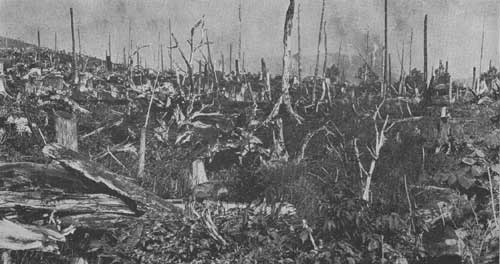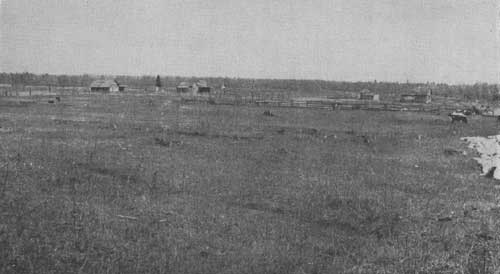|
Taming Our Forests
|

|
FOREST CITIES
This problem of establishing a permanent home is one that the Forest Service is trying to solve not only for its own members, but for others who work in the woods.
Under the earlier method of lumbering—"cut-out-and-get out"—there used to spring up lumbering towns in the center of great timber tracts. Overnight these would sprout stores and schools, churches, saloons, banks, and jails along Main Street. Perambulators would be pushed along the new sidewalks. Traveling salesmen would bring the latest thing in neckties and socks. At night, the sound of billiard balls from one side of the street would meet the sound of an organ or a college glee club from the other.
The engineer got up steam early in the sawmill, and the logs were fed in until dark. First came the nearby trees—everything cut and only the best used. The circle of cut-over land widened about the little town. Trees were brought from farther and farther away. No time to be careful that half-grown ones were not felled, that enough grown trees were left to scatter seed, that the seedlings were spared! The farmers of the Mississippi Valley were graduating from sod houses—they wanted houses of wood. There must be chairs and tables and beds and cradles in the new homes; fences about the new gardens; fuel for the new stoves. The railroads were pushing along from east to west, up from the south, down from the north, on tracks laid on wooden ties. The land was hungry for wood—the price was high—cut down the trees!
When the circle of cut-over land around a town grew so wide that it did not pay to drag logs across it, then the mill gathered itself up and moved on to another untouched timber tract. After it followed the engineers and firemen, and the lumberjacks, and the sawyers and the buckers, and all the men who had worked in the town. There were few people left to buy goods at the store; few children to go to the school; the church pews were empty; and no one had wages to deposit in the bank. No one repaired the sidewalks; no one mended the road. The only letters that went out through the post office were appeals for help to get away.

|
| Cut-over forest land. |

|
| Ghost town, Michigan. |
These desolate places are rightly called "ghost towns." They haunt the places where they were once alive. One in northern Michigan is represented by some rusted fire hydrants and a dilapidated frame building. One in Wisconsin, which once contained 7,000 people, has now 300, half of whom are on relief. One in Louisiana has one inhabitant—a darky who for 3 years has lived in an old bank vault. Wherever there has been this cut-out-and-get-out lumbering—taking one crop and destroying all those that might follow—are these ghastly ruins of human lives and hopes.
But forests do not have to be managed that way. With a crop of trees to be cut, not once in a century, but over and over again, a perpetual harvest plan that will keep men busy year after year instead of for a season or two, with no land cut bare of either seedlings or seed trees, a forest city need never die.
Such permanent communities are being established by the Forest Service. They will be modern towns with homes up to the American standard, stores, community centers, schools large enough to train all the children of the permanent population, and a mill to employ the men and use, year by year, only the timber that the forester decides is ready to be cut.
In towns like this—permanent communities dependent on the perpetual harvest of board feet—those who work in wood can find permanent homes.
| <<< Previous | <<< Contents>>> | Next >>> |
|
taming-our-forests/sec13.htm Last Updated: 19-Apr-2010 |